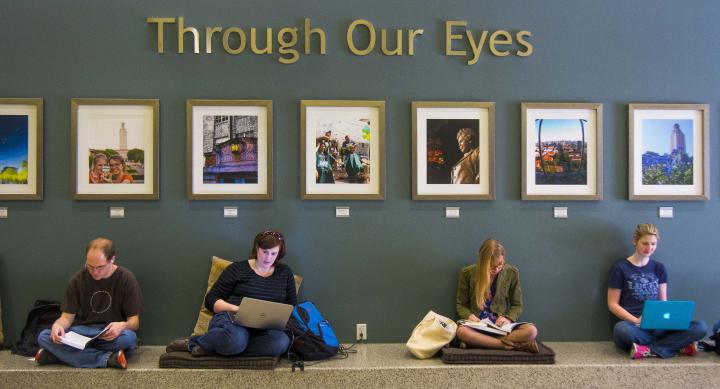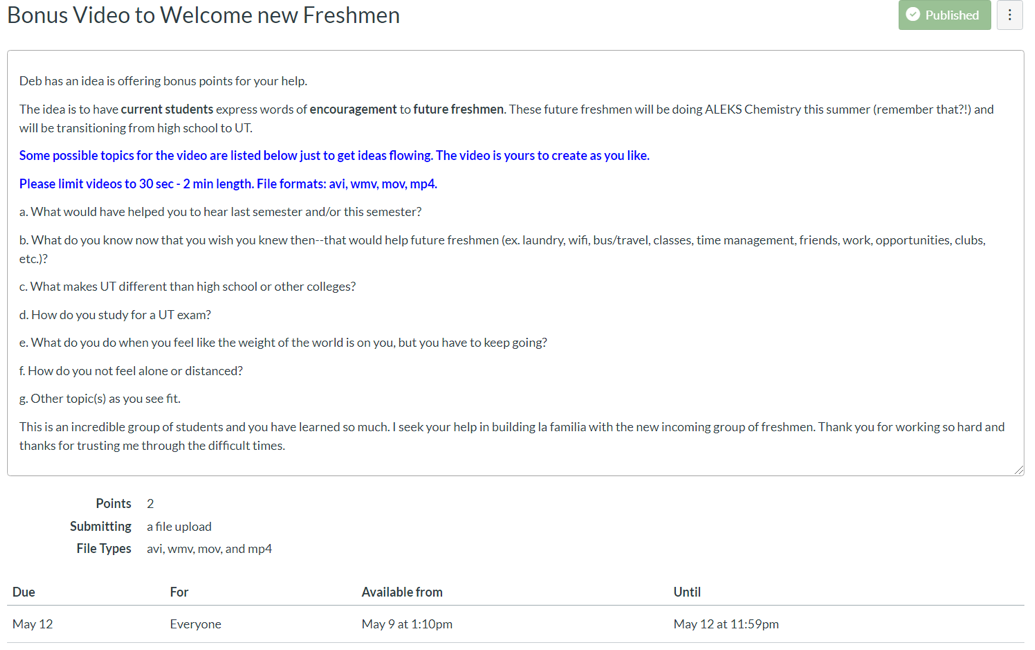
Students in their first year at UT encounter many challenges that can make them feel alone in their struggles, even as others in their classes hide the same feelings. Many professors reach out to students to offer advice and tips, but it is human nature to focus foremost on the advice originating from people who are similar—in situation, status, etc.—and faculty do not always fit that demographic from the students’ perspective.
One goal of this video project is to establish and nurture a “culture of learning” as well as a sense of “I belong here” for my students. To do this, we aim to share videos that offer firsthand accounts of first year struggles from UT students at the end of their freshman year to be shown to future students during their first year chemistry course. These videos are being recorded by students for students.
For the pilot version of the project, I offered bonus points at the end of spring 2018 semester for students to submit a video of themselves telling future freshmen what they would have liked to have been told. Then, supported by an CTL Microgrant, we catalogued the videos and combined them, patchwork-quilt-style, into one of three (3) videos to be shown during the fall 2019 first semester chemistry course. The three videos have the themes of (1) welcome and initial tips, (2) encouragement, balance, and mid-semester tips, and (3) end-of-semester tips. Thus far, the project has been successful in that students mentioned an appreciation for the comments in the initial video. It is interesting that the video doesn’t stand out as surprising, new, or different for them on a conscious level. It stands as a reminder that watching videos is nothing new to them, and watching people share tips is apparently nothing new to them.
Getting good-quality videos hasn’t been a big issue, surprisingly. I did get a few videos that were of something else entirely, like something from class, but the students are experienced at recording themselves and they seem at ease with doing so. We did get a couple of files that were degraded or couldn’t easily be read, but we dodged most of those problems by narrowing the file types allowed for upload. We built the bonus assignment in Canvas, which allows us to set accepted file types to avi, wmv, mov, and mp4.
Limiting the file types in Canvas proved very helpful, as did giving the students a few ideas to reflect on and think about. Working with Camtasia, we learned that I had to be logged into my Camtasia account in order to work beyond the “free trial” limitations of the software, even with Camtasia installed. We learned that lesson after attempts to import and splice multiple student videos made the program freeze or crash.
A screenshot of what I included in Canvas spring 2019 is shown below. I set it as an Assignment at the last days of the spring semester. After the due time, Canvas allows a download of the submissions.

I’m open to other video software submission options outside of Canvas, especially any that can facilitate grading of high counts of videos. It could be fun to have students practice explaining concepts on a video and have students grade one another’s submissions—potentially more productive than their current strategy of watching random videos across the Internet.
I’m not yet sure how to measure whether these videos are actually initiating or cultivating a “culture of learning” in the students watching them. I don’t have a way, outside of grades and drop rates, to gauge whether the videos are helping. I can see a lot of subconscious messaging about dorm room decorating, cultural norms, body language, tired eyes, etc., but I’m not sure which factors are the “low hanging fruit” that I should be measuring. From a different angle: I see anecdotal evidence that the videos are helping the older, end-of-year students to reflect on their freshman year and think about what helped them, what didn’t, what they struggled with, and how they coped or overcame it. But I don’t have a measure to capture all of that.
All of that said, this is a work in progress and a revealing one. In extending this opportunity to students and letting them talk about themselves as students, I am learning quite a bit about how they see themselves.

Deborah Walker is an Associate Professor of Instruction in the Department of Chemistry. This post is based on a presentation that Dr. Walker made to the Technology-Enhanced Learning collaborative.

